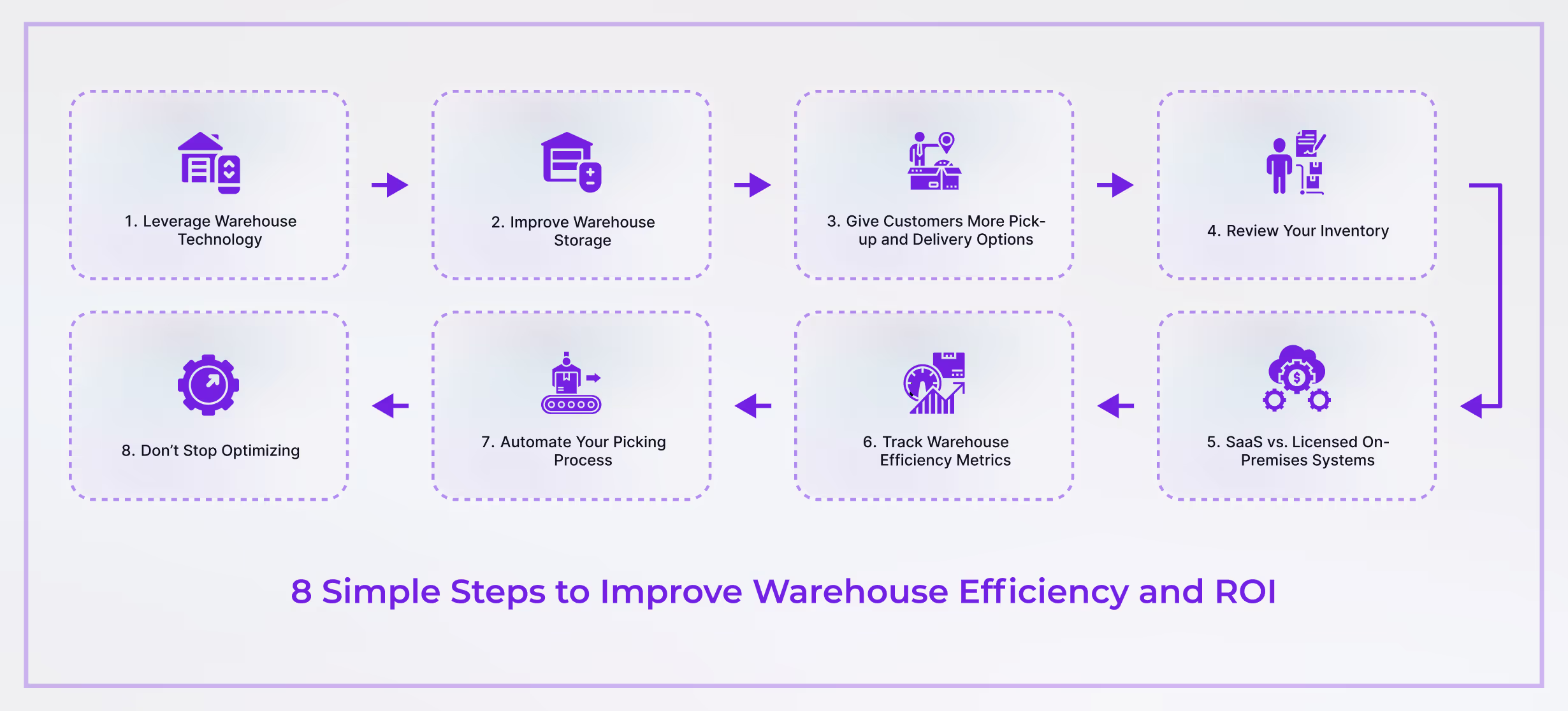Warehouse efficiency relies on three coordinated functions: your workforce, your customers or orders, and your inventory. Sounds simple, right?
However, it is not that straightforward in real. Warehouse efficiency is not about keeping the shelves stocked and delivering products to the customer on time only. Some warehouse ideas to boost productivity to improve customer experience, saving costs, and establishing a better working environment. There is a strong connection between warehouse efficiency and customer retention. Any loopholes in warehouse optimization can lead to a drop in customer retention rate, impacting your ROI.
Whether you have a small warehouse or a large one, you should standardize your processes and find new solutions to increase warehouse efficiency. The global warehousing and storage industry will reach USD 654920 million by 2028, reflecting the need for warehouse optimization and automation. There are several ways to improve warehouse efficiency that can significantly impact your profit margin and productivity.
Here are the eight necessary steps for improving warehouse efficiency and producing the required results.

1. Leverage Warehouse Technology
Today, more than 80% of warehouses lack any automation. Warehouse management systems (WMS) and ERP systems with a strong WMS module can boost efficiency by suggesting the best routes for picking or putting items away. Artificial intelligence can significantly can make warehouse management more accurate by automating various tasks, such as sorting and inventory management. This automation not only streamlines operations but also reduces the chances of errors, making the entire process smoother and more reliable. Furthermore, the system generates automated pick lists that can be sent to mobile devices and readers, reducing errors and reducing waste of paper and time. RFID and barcode readers can enhance the accuracy of transactions and increase picking accuracy. You will have a cleaner and greener warehouse.
2. Improve Warehouse Storage
Compared to a decade ago, warehouses are now over one-third larger and nearly three times as voluminous. Due to the increasing number of SKUs and other factors, larger footprints have increased facility costs.
Rather than expanding the footprint of your warehouse, consider better utilization of storage space. Increasing the height of the storage units and investing in the right equipment can allow you to store more in the same area rather than adding to expansion costs. Additionally, consider the types and variations of shelving depending on the materials you have in your warehouse for best results. Keep shelves neat and orderly by using standardized bins.
3. Give Customers More Pick-up and Delivery Options
Warehouses bear the burden of inventory. Offering in-store pick-up (BOPIS) and delivery can allow companies to shift a load of inventory to the retailers and warehouse distribution centers. Target offered pick-up options to its customers and revealed that 15% of their online purchases are now picked up.
You can sell products online even if your company doesn't have a brick-and-mortar storefront. A fulfillment center, such as the one operated by Amazon, can sell, store, and deliver goods to retailers. For improving warehouse efficiency further, Amazon has even introduced lockers where customers can pick up their orders instead of waiting for them to be delivered.
You can offer customers the option to select their preferred method of receiving their orders. This can include curbside pickup, contactless delivery, or flexible delivery windows, catering to their specific needs and preferences.
4. Review Your Inventory
Delivering products to customers does not reduce the time product lingers in your warehouse. Many companies are still holding on to a lot of inventory. Over the last five years, the inventory on hand based on an average sales day has increased by 8.3%. Therefore, you need to review and optimize your inventory because dead inventory in your warehouse costs money. For this purpose, you can analyze the metrics and perform an audit to identify the static inventory. Common metrics required to review inventory include:
- The average number of days to sell inventory
- Inventory turnover rate
- Return on investment (ROI)
- Gross profit on products
Holding inventory for a long time reduces warehouse efficiency and eats at your profit margin. So, you need to review your inventory and improve warehouse efficiency and productivity.
5. SaaS vs. Licensed On-Premises Systems
Investment in new order management systems, enterprise-wide or WMS that can be integrated occurs only every 5-10 years due to the extensive implementation process and investment involved. A SaaS subscription model can help you acquire a new system at a lower price.
There is, however, a difference between the long-term costs of SaaS versus buying the software once and requiring annual support of traditional software. Compare the detailed warehouse functions in SaaS WMS. You should find more effective functions for improving warehouse efficiency and decreasing warehouse costs.
6. Track Warehouse Efficiency Metrics
Warehouse productivity and efficiency can only be improved if you know:
- Which key metrics do you use to measure productivity and how to improve warehouse operations?
- Where does your baseline sit (i.e., where do you start from)?
- What is your target?
- What are you doing to track individual performances against those targets?
The warehouse efficiency metrics used by each company can differ, but they must be easily measurable. It won't be very useful if you spend a week trying to compile that data.
You need to either evaluate your systems or assess different warehouse efficiency measures. Consider breaking down your metrics. Taking productivity as an example, how do you measure it? Can several metrics measure it? If so, how? After that, identify key metrics that you can improve.
How to Measure Warehouse Efficiency
To holistically measure your warehouse performance, include the following practices in your regular procedures:
- Regular operational audits: These audits help evaluate warehouse operations, equipment, staff, and technology. Whether you do these internally or by third-party experts, this practice can highlight bottlenecks and potential risks.
- Set KPIs: Establish key performance indicators (KPIs) like receiving cycle time, space utilization, and put-away productivity. These metrics give you a clear picture of your warehouse's performance and help you track progress and identify areas for improvement.
- Track inventory accuracy: Your recorded inventory should match the physical stock to prevent issues like stockouts or overstocking.
- Monitor equipment efficiency: Keep a record of equipment maintenance and downtimes. This log will help you minimize downtime and ensure that your machines are running smoothly and efficiently.
- Assess and optimize warehouse layout: Regularly assess your warehouse layout to accommodate product demand, seasonality, and inventory turnover. This helps reduce unnecessary travel time and ensures that products are easily accessible.
- Get employee feedback: Listening to their suggestions can give you insights and identify problems to improve warehouse operations.
7. Automate Your Picking Process
Another way of improving efficiency is automating the picking process in warehouses. Using manual pickers for product delivery to the packaging and shipment area of the facility is not a scalable approach, especially for growing businesses. It affects warehouse productivity and efficiency significantly. With automation in the picking process, you can improve the pick rate to 300 pieces per hour.
For this purpose, you need to invest in sorters and conveyors that can move products within the facility quickly. As a result, the order picking productivity of your fulfillment center will drastically increase.
8. Don’t Stop Optimizing
Once you have your measures and benchmarks in place, you will want to refer to them regularly for improving warehouse efficiency.
To keep your workforce ahead of the curve, keep an eye on training, leadership, and technology developments. Get feedback from your customers on your service and improve warehouse efficiency where needed. Optimization to keep up with the latest trends is paramount in a constantly changing eCommerce environment.
{{returns-webinar}}
Wrap Up
These warehouse efficiency tips can help you streamline workflows, automate repetitive tasks, and minimize wasted time and resources. It takes more than just getting products out of the warehouse on time and keeping everything in its designated place for an effective operational warehouse. The objective is to maximize productivity to improve the customer experience and return on investment eventually.
A firm commitment to improving warehouse efficiency plays a crucial role in your business's growth and sustainability. You can increase your warehouse efficiency by leveraging technology in your warehouse management operations. With the help of PackageX apps and APIs, you can automate your warehouse logistics operations and increase speed, productivity, and efficiency.
FAQs
What are the factors that contribute to the efficiency of warehouse operations?
Warehouse efficiency is influenced by several factors, such as the size and layout of the space, using smart robots for picking tasks, the skills and experience of the staff, the level of customization and complexity of your Warehouse Management System (WMS). You should also take care of any limitations in the existing technology infrastructure.
How do you work faster in a warehouse?
To work faster in the warehouse, start by strategically placing your best-selling items in easy-to-reach locations. Group similar orders together to save time and divide the warehouse into zones for more organized picking. Maximize the pick face area by making items more accessible and keep similar-looking items separated to avoid confusion. Using a simple app can help guide your workflow efficiently. As you pick, sort items along the way, and consider adding a bit of fun by gamifying tasks to keep things engaging and motivating.




